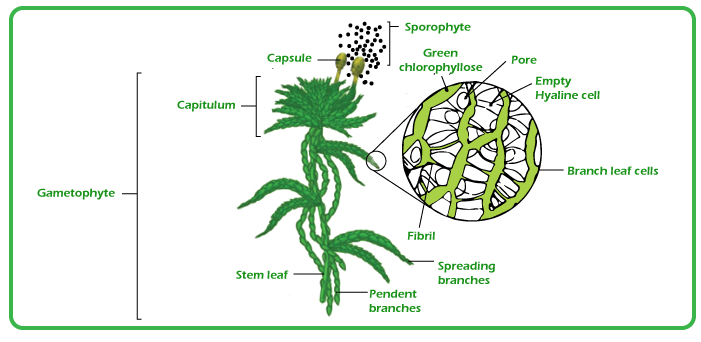Bryophyte
The word Bryophyta arises from the word ‘Bryon’, and the study of this is called bryology.
In-plant kingdom, bryophytes are non-vascular land plants that grow in damp environments. In these plants, reproduction occurs via spores; therefore, it does not have true vascular tissue. Bryophyte plants can survive without water, and they become alive after coming in contact with water.
Definition:- “Bryophyta are the type of non-flowering plant species that reproduce via spores and these are non-vascular (do not produce roots, leaves or stem)”
Types of bryophyte plants
| Mosses | From class Bryopsida, |
| Liverworts | From class, Hepaticopsida, and Marchantiopsida |
| Hornworts | From class Anthoceropsida |
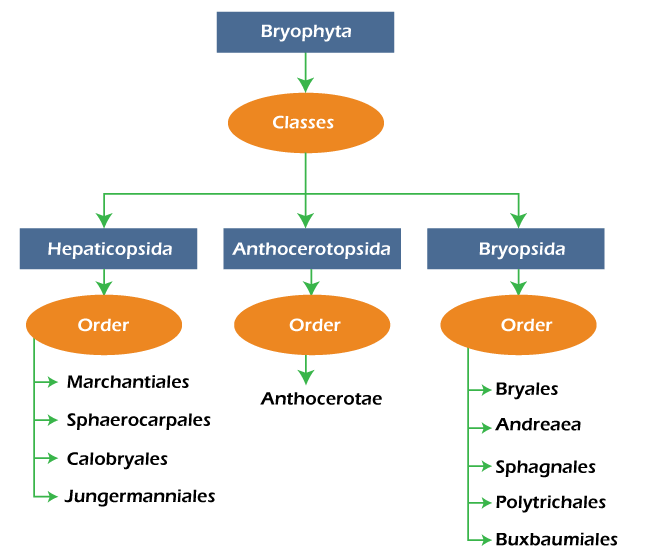
Some characteristics of bryophytes are:-
- These species of plants are found in damp and shady areas.
- These are non-vascular plants (lack of vascular system- the absence of xylem and phloem)
- Bryophytes have thallus body (prostrate or erect).
- These plants lack true vegetative structure (don’t have root, stem, and leave).
- Instead of roots, they have rhizoids that help the plant anchor to the surface, but they don’t absorb nutrients as other plant roots do.
- Mosses reproduce by releasing spores from their leaves. New mosses establish at new locations.
- Water is essential as these plants can revive themselves after contact with plants and continue their growth.
- These are considered amphibians of plants.
- The gametophyte is the dominant part of the plant called a haploid, and it is photosynthetic (it bears a multicellular sex organ).
- The thalloid gametophyte is distributed in three parts leaves, rhizoids, and axis.
- Antherozoids are produced by antheridium biflagellated fused with the eggs to form a zygote.
- Archegonium produces on eggs and is present in a flask-like shape.
- The saprophyte is semi-parasitic and multicellular in which zygote development takes place.
- Saprophytes rely on the gametophyte for their nutrition.
- Saprophyte cells go through the meiosis process, forming the haploid gametes that form a gametophyte known as protonema.
- The saprophyte is divided into three parts, i.e., seta, foot, and capsule.
Bryophytes major groups are:-
- Ferns- Ferns cannot produce speeds, but they have vascular tissues.
- Gymnosperms –They are called conifers in which vascular tissues are present. They cannot produce flowers despite producing cones and sees.
- Bryophytes are non-flowering plants and don’t have a vascular system like mosses.
- Angiosperms are flowering plants with vascular tissue that produce both flowers and seeds. There are two groups of flowering plants -monocots and dicots. Seed of monocots have one cotyledon, but dicot seeds have two cotyledons.
Example of monocots – Corn and lilies
Examples of dicots – Daisies, beans, and oak trees.
The reproductive life cycle of bryophytes
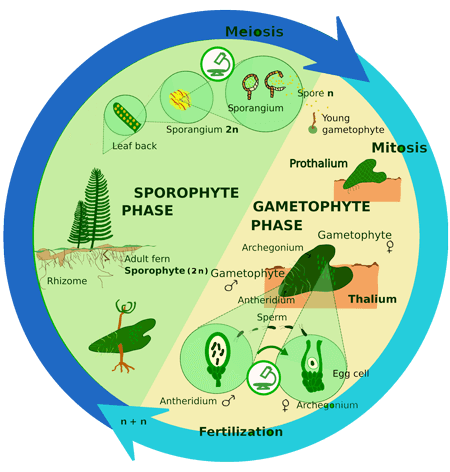
Reproduction of bryophytes shows alternation of generation between deployed saprophyte and haploid gamophyte.
At the gametophyte stage – Two specialized sex organs are formed called haploid gametes (male and female)
Male is known as the antheridia, and female is known as archegonia. Gametes have flagellated sperm that swim through water or are carried by insect species. A zygote (diploid) is formed by the fusion of sperm and egg (the two haploid gametes), growing inside the archegonia. Further haploid becomes a diploid sporophyte. The meiosis process generates haploid spores inside the sporangium, even when mature sporophytes remain attached to the gametophyte. All the dispersed spores become new gametophytes under a favorable environment. Here’s the reproductive life cycle of bryophytes.
Liverworts (Hepaticopsida)
These are tiny (extremely small) plants with flattened and undifferentiated stems. These are single-celled rhizoids (presence of membrane-bound-oil bodies within their cells). Liverworts contain enclosed lipid bodies. Types of liverworts are:-
- Riccia
- Perella
- Calgary
- Sphaerocarpos
- Bella
- Marchantia
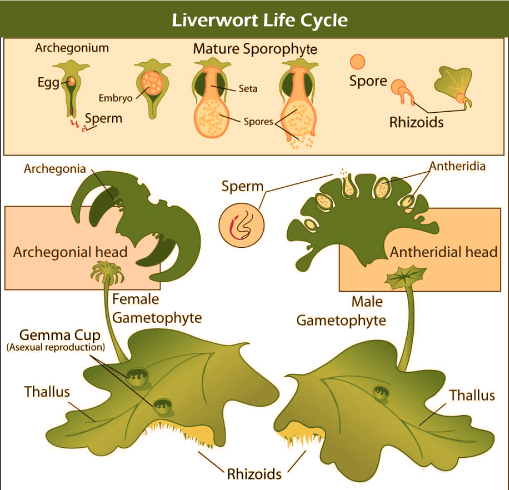
Liverworts are substitutes in 4 classes:-
- Calobryales
- For example- Colobryum
- Jungermannia
- For example- Pellia
- Sphaerocarpales
- For example- Sphaerocarpos
- Marchantiales
- For example- Riccia and Marchantia
Liverworts main characteristics are:-
- Absence of Columella in the capsule.
- Gametophytic tissues consist of sex organs that are borne dorsally.
- Gametophyte plant – thalloid (dichotomously branched, lobed, and dorsiventral) or foliose (leaves are dorsiventral and without midrib).
- Rhizoids are aseptate, branched, and unicellular.
- Thallus cells contain chloroplasts without pyrenoids.
- Saprophytes consist of foot or capsule(Riccia), seta and Marchantia.
Sexual and asexual reproduction takes place in liverworts:-
| Asexual reproduction | These asexual buds (gemmae) are multicellular and green in color. This asexual reproduction takes place by the formation of gemmae produced inside the gemma cup. This gemma cup detaches itself from the parent plant and grows into a new plant. |
| Sexual reproduction | Cells of saprophytes go through the meiosis process to form haploid spores and develop in gametophytes (photosynthetic and free-living organisms). The male organ (antheridium) produces sperm, and the female organ (Archegonium) produces an egg. They are present on the same thalli or different thalli where they fertilize, and the formation of a zygote develops into a deployed saprophyte. |
Hornworts (Anthocerotopsida)
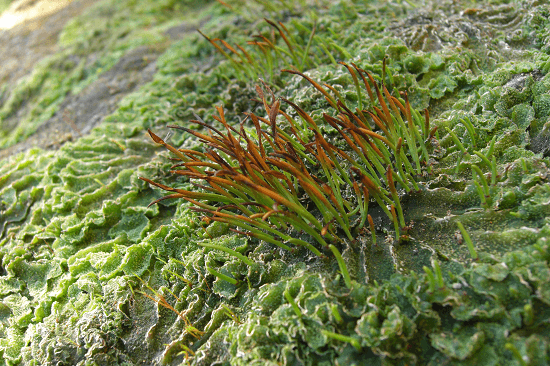
These named hornworts due to the development of horn-like saprophytes. Despite it, gametophyte type is a flat and green-bodied plant. Hornworts are present in garden soils, damp environments (tropical climates), and tree barks. Types of hornworts are:-
- Anthoceros
- Notothylus
- Megaceros
Some features of hornworts are:-
- These are of green color due to the presence of chloroplast in the cell with a pyrenoid.
- Columella originates from endothecium, which is present in the capsule.
- The gametophyte structure is flat, dorsiventral, and thalloid without internal differentiation.
- Capsules have pseudoelaters.
- Have small walled rhizoids.
- The thallus consists of sex organs.
- The structure of the saprophyte is distributed into the capsule, foot, and meristematic zone.
- Amphithecium helps in the development of the Sporogenous.
Sexual and asexual reproduction takes place in hornworts:-
| Asexual reproduction | Here asexual reproduction takes place under unfavorable conditions. This vegetative propagation occurs by fragmentation of thallus and tubers. |
| Sexual reproduction | Saprophyte is the upper part that develops from gametophyte and releases spores which develop into the gametophyte. This reproduction takes place by fertilization of sperm, and the egg develops into saprophytes. These sperms are waterborne travel from antheridium to Archegonium. |
Mosses (Bryopsida)
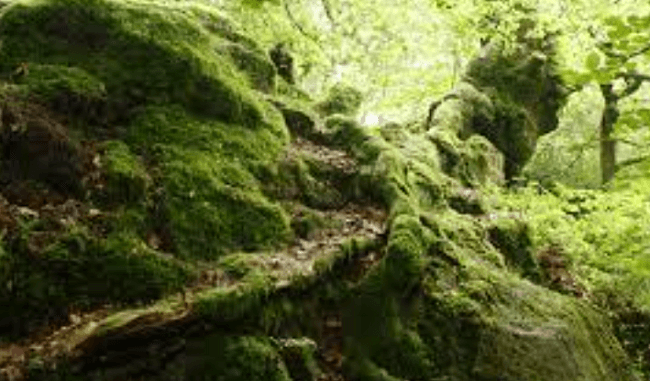
These are found in a moist environment, not in reach of direct sunlight. These are clumsy green plants whose leaves are one cell wide attached to a stem. Mosses are used for insulation, water absorption (water and nutrition transportation), and a source of peat. Types of mosses are:-
- Sphagnum
- Funaria
- Polutrichum
Mosses are divided in 5 orders:- Andreales, bryales, polytrichales, sphagnales and buxbaumiales. Some features of mosses are:-
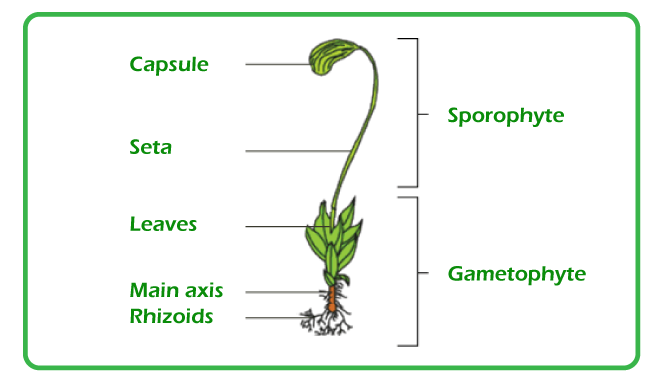
- In mosses, sex organs are borne on the stem, and elaters are absent.
- By separating the lid, the dehiscence of the capsule takes place.
- Foliose is left without a midrib and is made up of a stem as an axis.
- The gametophyte is divided into protonema and foliose gametophore.
- Rhizoids show multicellular features with oblique septa.
- Saprophytes divide into three parts, i.e., seta, foot, and capsule.
- Presence of Columella in mosses.
- Sexual and asexual reproduction takes place in mosses.
| Asexual reproduction | This reproduction takes place by fragmentation of secondary protonema and the budding process. |
| Sexual reproduction | Due to the absence of seeds, where gametophyte develops from spores. In this reproduction, fertilization takes place that produces sporophyte differ than liverworts. At the epical part of leafy shoots, antheridia and archegonia are present. |
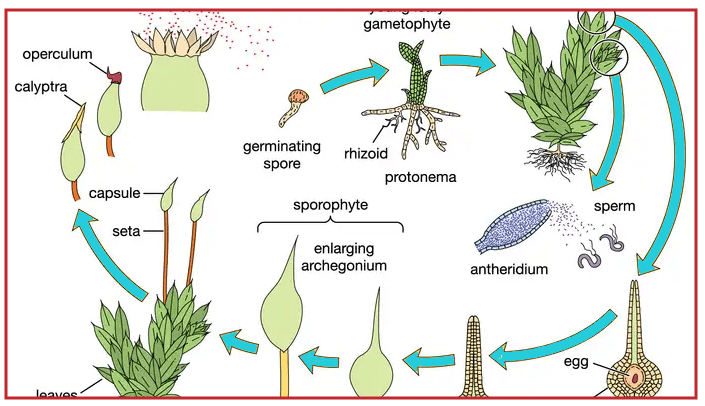
Difference between liverworts, hornworts, and mosses
| Liverworts | Mosses | Hornworts |
|---|---|---|
| Around 4500-5000 species in the world | Around 8000-10000 species in the world | Around 100-150 species in the world |
| Structure is small | Structure is large | Structure is large |
| Absence of chlorophyll | Presence of chlorophyll | Presence of chlorophyll |
| Absence of stomata | Presence of stomata | Presence of stomata |
| Seta is present in liverworts | Seta is present in mosses | Seta is absent in hornworts |
| The maturation of spores happen simultaneously | The maturation of spores happen simultaneously | Maturation of spores gradually. |
| Liverworts have a defined growth | Mosses have a defined growth | Hornworts grows continuously |
| It elaters the dispersion of pores | Dispersion of pores- peristome teeth | Pseudo – elaters the dispersion of pores |
| Dehiscence is longitudinal or irregular | Dehiscence is transversal | Dehiscence is longitudinal |
| The columella is absent in them. | Presence of Columella in mosses | Presence of Columella in hornworts |
| Present in simple capsule form | Present in differentiated capsule form(operculum or peristome) | Present in elongated capsule form. |
Importance of Bryophytes in various fields
- Medical field – Bryophyta have some antibiotic properties; therefore, they are used as or in medicine for curing various diseases. Lots of antibiotics are extracted from certain bryophytes consisting of antibiotic properties.
- Sphagnum has absorptive power and antiseptic property; therefore, it is used in surgical dressing to treat boils and discharge wounds. Sphagnum is used for filling the absorptive bandages in place of cotton. Dried sphagnum decoction is used for curing eye infection and acute hemorrhage.
- Marchantia – It helps in the affliction of the liver and in curing pulmonary tuberculosis.
- Peat-tar – It is used as a preservative and antiseptic.
- Spagnolo – It’s a distillate of peat-tar used to treat skin diseases.
- Polytrichium – These species help demolish and dissolve stones in the kidney and gall bladder.
- Research field – In genetics, mosses, and liverworts are used. Liverworts show the mechanism of sex determination in plants.
- In packing – Mosses (dried mosses) are used for packing fragile goods like bulbs and glassware. These are excellent packing materials used for the trans-shipment of living material (cutting and seedling) due to their water retention capacity.
- Food – Mosses become or provide food for birds, herbaceous mammals, and other mammals.
- Seedbeds – Bryophytes are used in seedbeds, greenhouses, and nurseries to root cutting due to their water-retention property. Sphagnum is used to maintain the high soil acidity required by certain plants.
- Peat formation is a dark color substance resulting from the decaying process (carbonization and compression of partially decomposed vegetative material in bogs). Peat is used as a fuel as coal is formed from the lower layer of peat. Sphagnum helps in improving the soil texture in horticulture; it is also called peat moss. Peat is responsible for producing dye, paraffin, ammonium sulfate, ethyl alcohol, ammonia, tannins, etc.
- Plant indicator – Some bryophytes indicate the basicity and acidity of soil as they grow in a specialized area like the growth of tortilla species indicates that the soil is rich in lime and other bases (occur as calcicoles) and acidity of soil indicated by Polytrichum species.
- Stone formation – Some of the species of bryophytes produce solid substances like travertine rock deposits, which are extensively used as building stones.
Bryophytes ecological importance
- Bryophytes act as soil binders because they grow very densely.
- They also recycle the nutrients.
- They reduce the impact of falling rain as they can hold the run-off water that helps in preventing soil erosion.
- They have the soil formation capacity as they decompose the rock to make it suitable for the growth of higher plants.
- The formation of soil takes place with the help of lichens and mosses.
- Acid secreted by lichens helps in the decomposition of soil.
- Mosses’ death and decay help in the formation of soil.
- Mosses can convert the open soil to dense forest as thick mats formed of mosses form a suitable environment for the germination of hydrophilic seeds. Seed germinate due to the presence of water and humus.
- Mosses help mesophytic development as they (decay and dead mosses and hydrophilic plants).
- Bryum (mosses) and algae act as rock builders as they are present in shallow water and lakes (rich in calcium bicarbonate). They form line rock (deposited around these plants) underwater by decomposing bicarbonate ions that result in the precipitation of insoluble calcium carbonate. This mineral deposit spread over a large area continues to grow and expand over a hundred square feet.


